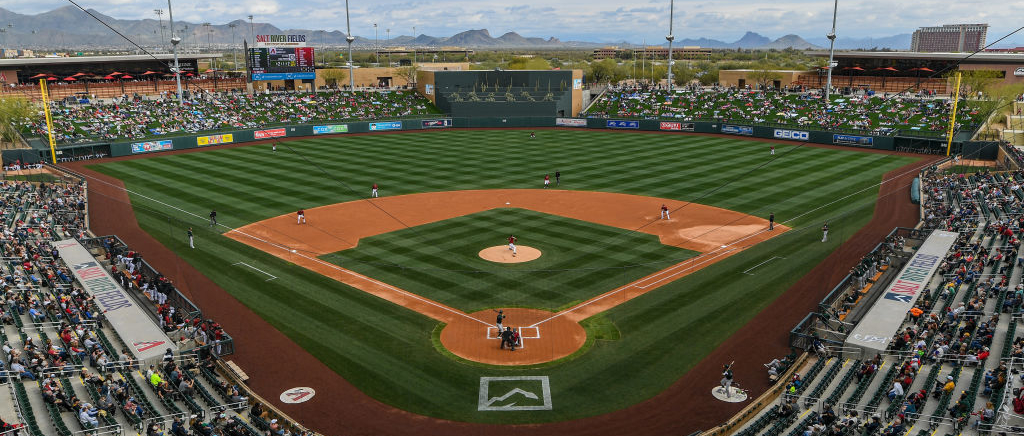
Because Major League Baseball’s season crashed before takeoff in the wake of the COVID-19 pandemic, the league understandably has acted with more urgency than other American pro team sports leagues to try to return to people’s lives. That urgency veered into desperation this week when reports indicated the league is willing to embrace a unique and gigantic undertaking in the Southwest in order to start the 2020 season, a strategy already nicknamed the “Arizona Plan.”
MLB seemingly has zeroed in on Phoenix as its Plan A for a “bubble league,” an idea that we’ve seen kicked around in other sports. Whereas the original Cactus League facility opened in Tucson, about an hour and a half south of the Phoenix metro area, today’s formation includes 10 ballparks within 50 miles of one another. Toss in the Diamondbacks’ own Chase Field and Arizona State’s Phoenix Municipal Stadium, and that’s 12 stadiums separated by, at most, a half-hour drive. The suburban sprawl makes for a pretty easy commute between parks, and most of the stadiums include spacious training facilities, as teams use the venues to practice, eat, and work during the spring in addition to play games.
Structurally, MLB’s plan makes sense. But as with any of the reports emanating from sports executives during this pandemic, there are holes in it.
Consider first the size of the undertaking. Ken Rosenthal of The Athletic reported on Tuesday night that MLB is considering expanding rosters “to as many as 50 players” to help handle the compressed schedule and relative likelihood that players become sick. Several reports indicate the league does not intend to shut down if players become infected with the novel coronavirus. That means this plan would include at least 50 players in addition to the coaching staff, training staff, and front office. It’s not a stretch to imagine each team would itself need about 100 personnel just from the baseball operations side, not to mention the dozens of people involved in managing each facility. Stretch that out to include the hospitality workers — who themselves would have to potentially live at the hotel to properly physically distance — and it’s easy to see why Rosenthal and others have reported MLB envisions thousands of people being involved in the “Arizona Plan.”
Phoenix is not small. Already, local officials are wondering how American cities might sustain the power grid or emergency response staff if smaller or less-prepared cities than New York or Chicago sustain big waves of infection. Cactus League facilities stretch from Mesa, itself a city of 500,000 or so, where the Cubs and A’s typically play, to Goodyear, home to a sizable Air Force Base and a big Amazon distribution center. As we’ve seen, not moving or coming into contact with other people is the best way to mitigate the spread of COVID-19. Mandating the travel of thousands of people to and from work in the country’s fifth-biggest metropolitan area becomes quite risky.
As one Phoenix physician put it to the Associated Press, “You have to realize, maybe all of them could get it, and that’s going to be a cluster.”
Arizona is also crushingly hot. It doesn’t reach 125 degrees, like one anonymous player quipped to Andy McCollough of The Athletic, but it’s a place where heat warnings are in effect all summer, to the point that recesses are occasionally cancelled for school children. Sure, pro athletes are in better shape than 9-year-olds, but there’s a reason Chase Field has a dome, while the Cactus League facilities are all open-air. There’s no feasible way to ensure that no games are played in the Cactus League venues during the day, unless MLB commits to a drastically reduced schedule, with Chase Field hosting day games and the Cactus League stadiums only hosting games at night.
The player in McCollough’s piece was certainly right when he worried about the prospect of playing 20 days in a row, with more frequent double-headers in the Arizona heat. On the other hand, Diamondbacks CEO Derrick Hall appeared to fudge the facts a bit when he said on local radio, “This is going to be a place where hopefully, if we do things right, where we keep that curve flat, where it doesn’t become too much of a problem, where the summer is going to heat up a little bit.”
There is no definitive research showing that this novel coronavirus will be seasonal like other similar viruses. Plus the Arizona Department of Health Services deemed the virus “widespread” among the community weeks ago, and COVID-19 testing remains a major problem in the state, which has tested less than 1 percent of its population.
Understandably, there is hope among local officials that they can be part of shepherding sports back into Americans’ lives as a distraction and source of joy. “At the city, we value flexibility and innovation and are willing to work with the many different sports franchises that call Phoenix home, but only if public health leads every single discussion,” Phoenix mayor Kate Gallego said in a statement on Tuesday.
No one is arguing that the return of sports, baseball or otherwise, would be a welcome reprieve from our world’s hellish spring. Yet considering the scope of a 30-team league and circumstances on the ground in Arizona, being decisive won’t be enough for the “Arizona Plan” to succeed.
